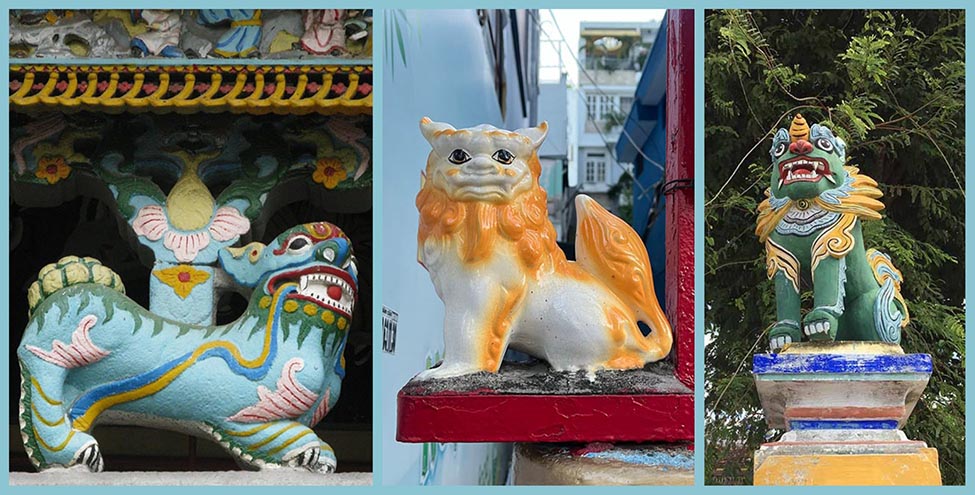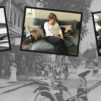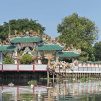
Surprise!
These, believe it or not, are versions of the Asian unicorn. Surprised? I certainly was when I started to do some research on this interesting looking beasty. After I eventually discovered that con Kỳ Lân translates to unicorn, it’s obvious that it bears no resemblance to the white horned horse-like unicorns we read about in fantasy books or decorate a child’s birthday cake with. In fact, many Asian unicorns don’t have a horn at all.
A bit of history:
According to some sources, Kỳ Lân first made its appearance in Vietnam around 600 AD. Inspired by the Chinese mythical creatures known as Qilin, the Ky Lan is thought to have been introduced here via Chinese traders. Not surprisingly, the Vietnamese versions differ to those from China in that local unicorns are described as having big eyes, a large nose, a ruffled or fanned tail, and appearing cheerful and friendly (not sure that this is confirmed by my photos…). The Chinese Qilin, on the other hand, are typically fierce and threatening in appearance.
A hybrid-like creature, the Ky Lan take on many forms, influenced by whatever regional folkloric story it has been connected to. Its appearance can include individual features from a variety of animals, including the lion, deer, dragon, horse, tiger, crocodile, eagle, dog and, inexplicably, the giraffe and hyena. I have seen iterations in the north of Vietnam with horse-like bodies and long deer-like legs; some are said to have the head of a dragon; others may have the claws of a crocodile. I personally prefer the variety of I have captured here, especially the unicorn in the middle, because it bears similarities to our sweet, feisty, little dogster who passed away recently ????. She had the mane of a lion and a gloriously fluffy tail like some of the unicorns I have seen in both central and southern Vietnam. Some researchers claim that Ky Lan was a lion that the Buddha domesticated.
Mythical creatures:
The Asian unicorn is one of Vietnam’s four mythical creatures, which also includes the dragon, phoenix and turtle. Ky Lan are often found at the entrances of temples and pagodas, sometimes on walls or the roof, and they are considered to have the power to protect the buildings from bad spirits.
The Lion Dance might actually be a Unicorn Dance
I was surprised to learn recently that the Lion Dance (múa Sư Tử) may instead be a Unicorn dance (múa Lân), in the southern parts of Vietnam anyway. Typically performed during important annual celebrations such as the recent Mid-Autumn festival/Tết trung thu and Tết/the Vietnamese new year, as well as for the opening of larger businesses, the unicorn dance includes Ông Địa (the round faced Earth God), who travels down to earth and dances with the Ky Lan. This is one thing that makes the Unicorn dance different to the lion dance performed throughout many Asian countries.
There’s also another point of difference to watch out for. While both the Lion and Unicorn dance appears similar (so much so that even some locals cannot tell the difference), Ky Lan will have tiny horns located in the middle of their heads. But not all of them will have horns. In that case, look out for Ong Dia and you will know. Dancing Lions, on the other hand, will never have a horn.
On top of that, there are regional versions to consider. Generally, the Lion dance is performed in Northern Vietnam. In the south, it is likely to be the Unicorn dance. But not always… In any case, it is believed that wherever a unicorn appears, people will have peace, happiness, prosperity, and longevity.
So, now that you are all clued up (well, perhaps at least a little more than you were before), you can start looking up at pagoda walls, on temple roofs and at events where Vietnamese people wearing mythical creature suits are dancing, and ask yourself, “Is that a unicorn?” It’s likely that it wasn’t a question you thought to ask before.
If you find these little creatures interesting, you might like to join one of our Very Dep walking tours. The “Vintage cafes and more” walk in Phu Nhuan District, Ho Chi Minh City, passes by the Ky Lan that looks like our wee pupster. There is an even larger version sitting in one of the vintage cafes we stop at for a drink. I’d be happy to point both of them out to you. Check the Upcoming Events section on our website to find out more about the tour or to book a spot on the next morning walk.






